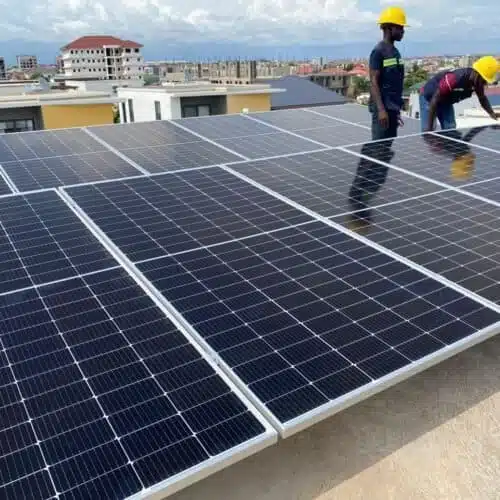Blogs
How Does Solar Energy Work? Unveiling the Power of the Sun

Solar energy work by capturing sunlight and converting it into electricity. This process involves solar panels, which contain photovoltaic cells that absorb sunlight.
Understanding solar energy is important in today’s world. As we face environmental challenges, many seek cleaner energy sources. Solar energy offers a renewable and sustainable option. But how does it actually work? In this blog post, we will explore the basics of solar energy.
We’ll look at how sunlight turns into usable power for homes and businesses. Whether you’re curious about green energy or considering solar panels, this guide will help. Let’s dive into the fascinating world of solar energy and see how it can benefit us all.
Introduction To Solar Energy
Solar energy is the power derived from the sun’s rays. It is a clean, renewable source of energy. Understanding how it works can help us appreciate its potential.
The Sun As An Energy Source
The sun is a massive, glowing ball of gases. Every second, it produces immense energy. This energy travels to Earth in the form of light and heat. Solar panels capture this energy and convert it into electricity.
Historical Use Of Solar Power
Humans have used solar power for thousands of years. Ancient civilizations used sunlight to light fires with magnifying glasses. In the 7th century B.C., they used mirrors to focus sunlight. By the 19th century, inventors began creating devices to harness solar energy.
In 1839, a French scientist named Edmond Becquerel discovered the photovoltaic effect. This discovery led to the development of solar cells. In the 1950s, scientists created the first silicon solar cell. It was a breakthrough in solar technology.
Today, solar energy is a vital part of our energy mix. It powers homes, businesses, and even vehicles. It is a key player in the move towards sustainable energy.
Photovoltaic Technology
Solar energy is a clean and renewable power source. At the heart of solar energy is photovoltaic technology. This technology converts sunlight into electricity. It uses special cells called solar cells. These cells are grouped into panels. Let’s dive deeper into how this works.
How Solar Panels Work
Solar panels absorb sunlight using photovoltaic cells. These cells are made from silicon. When sunlight hits the cells, it creates an electric field. This electric field produces electricity. The more sunlight the panels receive, the more electricity they generate.
The electricity generated is direct current (DC). Homes use alternating current (AC). So, an inverter converts DC to AC. This converted electricity powers homes and devices. Any excess electricity can be stored or sent to the grid.
Types Of Solar Cells
There are different types of solar cells. Each has unique features. Here are the main types:
- Monocrystalline Solar Cells: These are made from a single crystal of silicon. They are efficient and last long.
- Polycrystalline Solar Cells: Made from many silicon crystals. They are cheaper but less efficient.
- Thin-Film Solar Cells: Made by layering thin films of photovoltaic material. They are lightweight and flexible. Less efficient but useful for certain applications.
Each type has its advantages and best use cases. Choose based on your needs and budget.
| Type of Solar Cell | Efficiency | Cost |
|---|---|---|
| Monocrystalline | High | Expensive |
| Polycrystalline | Medium | Affordable |
| Thin-Film | Low | Cheap |
Understanding these differences helps in making an informed choice. Solar energy is the future. Embrace it today.
Solar Thermal Systems
Solar thermal systems use the sun’s energy to generate heat. This heat can be used for various applications, such as water heating, space heating, and even electricity generation. These systems are efficient and environmentally friendly. They help reduce carbon footprints and save on energy costs.
How Solar Thermal Works
Solar thermal systems capture sunlight using solar collectors. These collectors are usually installed on rooftops or open spaces. They contain a fluid that absorbs the sun’s heat. This fluid can be water, oil, or a special heat-transfer fluid.
The heated fluid is then circulated through pipes to a heat exchanger. The heat exchanger transfers the absorbed heat to water or air. This heated water or air is used for various purposes, such as heating buildings or generating electricity.
Applications Of Solar Thermal Energy
Solar thermal energy has many applications. Here are some of the most common:
- Water Heating: Solar thermal systems can heat water for domestic use. This includes showers, washing machines, and dishwashers.
- Space Heating: These systems can heat indoor spaces. This is particularly useful in colder regions.
- Industrial Processes: Many industries use solar thermal energy for processes like drying, distillation, and sterilization.
- Electricity Generation: Solar thermal power plants use mirrors to concentrate sunlight. This generates high temperatures, which can produce electricity.
Solar thermal systems are versatile and can be adapted to different needs. Their efficiency and eco-friendliness make them an excellent choice for sustainable energy.
Solar Energy Storage
It is a clean and renewable source of power. But what happens when the sun is not shining? This is where solar energy storage comes into play. It allows us to save the energy produced during sunny periods for use at night or on cloudy days. Let’s explore two main types of solar energy work storage methods: Battery Storage Solutions and Thermal Storage Methods.
Battery Storage Solutions
Battery storage solutions are one of the most popular methods for storing this. They involve using batteries to store the electrical energy generated by solar panels. These batteries can then provide power when there is no sunlight.
| Battery Type | Advantages | Disadvantages |
|---|---|---|
| Lithium-Ion | High efficiency, long lifespan | High cost |
| Lead-Acid | Low cost, reliable | Shorter lifespan, lower efficiency |
Using batteries for solar energy storage ensures a steady supply of power. It is especially useful for residential and commercial applications. Here are some key benefits:
- Energy Independence: Store energy for use during power outages.
- Cost Savings: Reduce electricity bills by using stored energy.
- Environmental Impact: Reduce reliance on fossil fuels.
Thermal Storage Methods
Thermal storage methods involve storing solar energy work in the form of heat. This heat can be used to generate electricity or for direct heating purposes. It is a versatile and efficient way to store energy.
There are various thermal storage methods, such as:
- Molten Salt Systems: These systems store heat in molten salt, which retains heat for long periods.
- Phase Change Materials: These materials absorb and release heat during phase changes.
- Water Tanks: Simple and cost-effective, used for heating water.
Thermal storage methods offer several advantages:
- Long-term Storage: Retains heat for extended periods.
- Versatility: Suitable for various applications.
- Efficiency: Reduces energy loss compared to electrical storage.
Both battery storage and thermal storage methods play a crucial role in making solar energy reliable. They ensure that we can use solar power even when the sun isn’t shining.
Benefits Of Solar Energy
Solar energy is a clean and renewable source of power. It offers numerous benefits for the environment and the economy. Let’s explore some of these advantages in detail.
Environmental Impact
Solar energy work significantly reduces greenhouse gas emissions. Unlike fossil fuels, solar power does not release harmful pollutants into the air. This helps combat climate change and improve air quality.
Solar panels require very little water to operate. This contrasts with traditional power plants that use thousands of gallons of water daily. Preserving water resources is crucial, especially in arid regions.
It also reduces our reliance on finite resources. Fossil fuels are limited and will eventually run out. Solar power, on the other hand, is abundant and sustainable.
Economic Advantages
Switching to solar energy can lead to significant cost savings. Once installed, solar panels provide free electricity. This can lower or even eliminate monthly utility bills.
This systems can increase property value. Homes with solar installations often sell for more than those without. Potential buyers see the long-term savings and the environmental benefits.
Solar power creates jobs. The solar industry employs thousands of people in manufacturing, installation, and maintenance. This helps boost the local economy and provides stable employment opportunities.
These making solar energy more affordable for homeowners and businesses.
|
Benefit |
Description |
|
Cost Savings |
Free electricity after installation, lower utility bills. |
|
Increased Property Value |
Homes with solar panels sell for more. |
|
Job Creation |
Solar industry provides stable employment. |
Challenges And Limitations
Solar energy is a sustainable and environmentally friendly power source. Yet, it faces several challenges and limitations that affect its efficiency and reliability. Understanding these challenges can help in finding better solutions to make solar energy more effective.
Efficiency Issues
Solar panels convert sunlight into electricity, but their efficiency is not always optimal. The average efficiency of solar panels ranges from 15% to 20%. This means a significant portion of sunlight is not converted into usable energy. Several factors can reduce efficiency:
- Quality of materials: Higher quality materials can improve efficiency, but they are often more expensive.
- Age of the panels: Solar panels lose efficiency over time, typically about 1% per year.
- Installation angle: The angle at which panels are installed affects how much sunlight they capture.
Weather Dependence
It is highly dependent on weather conditions. Panels need sunlight to generate power, so cloudy or rainy days can significantly reduce energy production. There are several weather-related challenges:
- Seasonal variations: In winter, shorter daylight hours and lower sun angles reduce energy output.
- Cloud cover: Heavy clouds can block sunlight, drastically cutting energy production.
- Dust and debris: Accumulated dust or debris on panels can block sunlight, reducing efficiency.
To address these issues, regular maintenance and proper installation are crucial. Optimizing the angle and cleaning the panels can improve their performance.
Innovations In Solar Technology
It has been a reliable source of clean power for years. Innovations in solar technology have made it more efficient and accessible. These advancements are paving the way for a sustainable future. Let’s explore some of the latest developments in solar energy.
Emerging Solar Technologies
New technologies are constantly being developed in the solar industry. These innovations aim to improve efficiency and reduce costs. Some of the most promising emerging solar technologies include:
- Perovskite Solar Cells: These cells are cheaper and easier to manufacture than traditional silicon cells.
- Bifacial Solar Panels: These panels can capture sunlight from both sides, increasing energy output.
- Flexible Solar Panels: These lightweight panels can be installed on various surfaces, including roofs and vehicles.
Future Trends In Solar Energy
The future of it looks bright. Several trends are shaping the industry and will continue to do so. Some of the key future trends in solar energy include:
- Solar Storage Solutions: Advances in battery technology will allow for better storage of solar energy.
- Smart Solar Grids: These grids will enable better management and distribution of solar power.
- Solar-Powered Transportation: It will play a significant role in the future of electric vehicles.
These innovations and trends are driving the solar industry forward. They are making solar energy more efficient and accessible. As technology advances, solar power will become an even more vital part of our energy landscape.
Implementing Solar Energy
It is a powerful and sustainable solution. It harnesses the sun’s rays to generate electricity. This clean energy source reduces reliance on fossil fuels. Learn how solar energy work can be implemented in various settings.
Residential Solar Solutions
Residential solar systems are becoming more popular. They help homeowners save money on electricity bills. These systems usually consist of solar panels installed on rooftops. The panels capture sunlight and convert it into electricity.
Here are the main components of a residential solar system:
- Solar Panels: Capture sunlight and generate direct current (DC) electricity.
- Inverter: Converts DC electricity to alternating current (AC) for home use.
- Mounting System: Secures solar panels to the roof.
- Battery Storage: Stores excess energy for later use.
- Net Metering: Allows homeowners to sell excess electricity back to the grid.
Commercial And Industrial Applications
Commercial and industrial sectors also benefit from solar energy. These systems are larger and provide significant energy savings. Businesses can reduce their carbon footprint and energy costs.
Here are key components of commercial and industrial solar systems:
- Solar Panels: Capture sunlight and generate large amounts of DC electricity.
- Inverters: Convert DC electricity to AC for business operations.
- Mounting Systems: Can be ground-mounted or installed on large rooftops.
- Energy Management Systems: Optimize energy usage and monitor performance.
- Battery Storage: Ensures a steady energy supply and reduces peak demand charges.
Businesses can also take advantage of government incentives. Tax credits and rebates make solar installations more affordable. Investing in it is a smart choice for long-term savings.
Global Solar Energy Initiatives
Countries are taking steps to promote solar energy. Here are some notable global initiatives:
| Country | Initiative |
|---|---|
| Germany | Feed-in tariffs that guarantee a fixed price for solar energy producers. |
| India | National Solar Mission aiming for 100 GW of solar power by 2022. |
| China | Leading in solar panel manufacturing and large-scale solar farms. |
These efforts help increase the adoption of it. They also contribute to sustainable development.
Frequently Asked Questions
What Is Solar Energy?
Solar energy is power from the sun’s rays. It is converted into electricity or heat using solar panels or solar thermal systems.
How Do Solar Panels Work?
Solar panels work by converting sunlight into electricity. They contain photovoltaic cells that generate direct current (DC) power, which is then converted to alternating current (AC) for use.
What Are The Benefits Of Solar Energy?
It is renewable and reduces electricity bills. It is also environmentally friendly, decreases carbon footprint, and requires low maintenance.
Can Solar Energy Power A Home?
Yes, it can power a home. Solar panels generate electricity that can meet a home’s energy needs, reducing reliance on the grid.
Conclusion
Solar energy powers homes and businesses efficiently. Sunlight converts into electricity through solar panels. This clean energy source reduces carbon footprints and saves money. It’s sustainable and eco-friendly. Understanding it helps make informed decisions. Embrace this technology for a greener future.
Switching to this benefits both the environment and your wallet. By harnessing the sun’s power, you contribute to a healthier planet. Start exploring it options today.






















